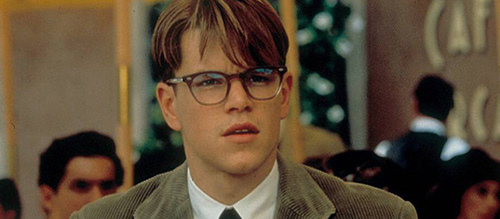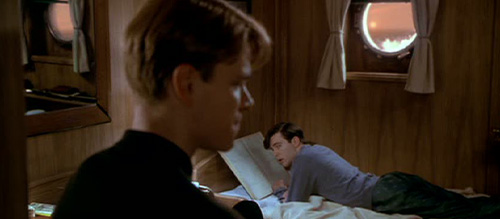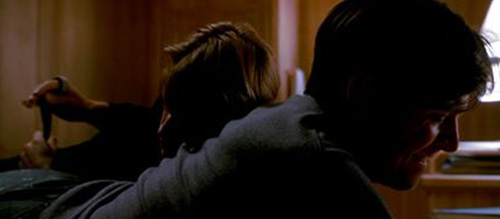How Every Element in the Final Sequence from ‘The Talented Mr. Ripley’ Works To Create A Wonderfully Disturbing Finale
This article was written exclusively for The Film Magazine by Sophie Cook of Sophie Beatrice’s Blog.
Ever since Anthony Minghella’s The Talented Mr. Ripley (1999) was released, fans and critics have been in awe of the cinematic tropes and expressive artistic choices displayed throughout the film. The Talented Mr. Ripley tells the story of Tom Ripley, played by a young Matt Damon, who travels to Venice to convince Dickie (Jude Law) to return to the US on his father’s request – Tom actually befriends Dickie’s father through false pretence at a Princeton University reunion (a university he never attended). The plot follows Tom as he makes friends with Dickie, pretending they have a backstory from Princeton, and becomes obsessed with his lifestyle – so much so that he begins to impersonate him as the narrative develops.
The film’s greatest achievement, and the moment that explores this tension in the most depth, is the final sequence. This sequence represents the last straw for Tom Ripley (Matt Damon) in his struggle between being himself and adopting another life – a struggle which ultimately results in him deciding to throw his real life away.
Throughout The Talented Mr. Ripley, Damon convincingly and eerily conveys Ripley’s character, expressing creepy mannerisms and an ultimately dark characterisation through expressive facial movements that work to communicate the individual’s complex personality. Damon portrays a shyness, combined with a strangeness, through both his awkward physicality and his unique delivery of the dialogue, cleverly portraying the other attributes of his character – most notably his more innocent and attractive traits – through his charming interaction with other characters and his emotional engagement, aspects that make him an utterly watchable and almost likable central character. Damon’s likable characterisation also increases his character’s impact upon the audience, making it even more surprising and scary when he unveils the darkness within him, his portrayal shifting as Minghella’s mise-en-scene transforms to emphasise the minute aspects of his performance, the cinematography elevating this powerful combination as arguably the most important cinematic element in the whole film.
The final sequence begins in the cabin of a boat, with Tom Ripley and Peter (his partner at the time, played by Jack Davenport). The entire sequence takes place in their cabin, bringing about an expectation of threat from Ripley that ensures that this section is extremely claustrophobic and uncomfortable to watch, not least due to the proximity at which Minghella positions us via the camera.
The camera’s position and placement throughout this sequence is significant; an over-use of over-the-shoulder shots (from Tom’s perspective) effectively emphasise the symbolic distance between the two characters while ensuring we are never too far from their tension. Tom has manipulated Peter in the narrative, and this untruthfulness is reflected in the physical distance between them – the camera’s position almost creates an element of dramatic irony, as it foreshadows the ultimate betrayal Tom commits on Peter, which Peter is obviously unaware of. The use of over-the-shoulder shots also portrays Tom’s dominance in this scene, prominently the high-angle, which furthermore adds to the uneasy atmosphere as the audience somewhat suspect that Tom has dark intentions for Peter.
This use of camera placement could be compared to the choices of Hitchcock, as the over-the-shoulder shot is frequently used in his films when ramping up tension. For example, in Psycho, Hitchcock uses many of these shots to create an almost constant sense of unease, cleverly communicating exactly what that character is seeing. There, we are each positioned with the character Hitchcock intends for us to identify with, and we are therefore encouraged to follow their emotional journey by being placed almost directly in their shoes. In The Talented Mr. Ripley, Anthony Minghella positions us with Tom, asking us to adopt the character’s predatory eye, thus increasing our concern for Peter and the likelihood that Tom may strike at any moment.
Recommended for you: Top 10 Alfred Hitchcock Films
These over-the-shoulder shots are frequently mixed with close ups, which poignantly convey Tom’s rising internal panic, as the spectator uncomfortably views his facial expressions and reactions up close, the frame offering nowhere for us to hide. This increases the dramatic irony, as the audience know of his dark nature but Peter does not. A key example of this is the use of a medium close up of Tom laughing at Peter’s naivety, as he asks, “Why lie?”, and Tom’s response (referring to himself as Dickie – the personality he steals from Jude Law’s character), confirms to the audience that their relationship is built on lies. This scene is cut using shot-reverse-shots, which create a fast-paced continuity which intensifies the action in the scene; as the characters are mostly stationary, the quickfire shot-reverse-shot adds some energy to the dialogue. It is unknown at this point whether Tom is going to change and open up to Peter, but this is soon confirmed to not be the case as he asks, “Tell me some good things about Tom Ripley…”, and lays down with his head on Peter’s back – symbolic of his power in this situation but also the aspect of pathetic childish insecurity in his personality.
These close-ups and their cousin, the extreme close-up, are continuously returned to throughout this sequence as an effective way of conveying the intensity of Tom’s character and the rising tension occurring in his cabin. It creates an intense and overwhelming atmosphere because of its invasiveness, which is in contrast to how often close ups are used in cinema to encourage sympathy from the audience. The camera focuses on Damon’s contrasting emotions; the character is smiling one minute, and close to tears the next. Using close up shots to communicate Tom’s complex thought processes cleverly reflects his split personalities in playing both Tom and Dickie, and importantly they ramp up the tension even further, slowly unraveling the likely drastic action Tom will take to ensure his survival.
Lighting is also used as an important communicative device in this scene, creating a visual darkness to convey the underlying darkness of the narrative. The only lighting throughout this sequence is low-key, displayed through the lamps visible within the frame. This artificial, but naturalistic dim lighting, alongside the claustrophobic location, helps the framing and editing to create the depressing tone of the action and the grim foreboding each aspect is working towards us noticing. The use of low-key lighting here evokes Film Noir, and especially classic releases such as Wilder’s Double Indemnity (1944), where the dark colours and use of contrasts in the lighting create an ominous tone to the action and a clear view of the moral black and white, good and evil narrative at its core.
In addition to the Noir inspired lighting and the Hitchockian camera placement, the colour palette of this sequence also adds to the darkness within the narrative and its central character Tom, the colour scheme being dull, including lots of browns and greys – one reason could be to suggest Tom’s feelings of dullness and boredom in his own real life, whereas another reading could be that Tom is beginning to blend his two lives (the one of Tom, and the one he stole from Dickie) together. The costume design places Tom in a black outfit, connoting his inner darkness and his capability of murder, as Peter’s grey outfit connotes misery and the impending doom of his death, while still presenting the character as being a faded colour that can blend into the background, just as Tom is beginning to see him as yet another person standing in his way. The contrasting costume choices for Tom and Peter signify the negative development between the characters, how their lives have been derailed (mainly Tom’s), and ultimately outline Tom’s foreseeable fate.
The visual dullness of the mise-en-scene is nicely juxtaposed with the frantic nature of the camerawork. Continuously in this scene, the camera movement represents the bobbing of a boat, as it moves up and down constantly, which creates immersion for the spectator because they feel as if they, too, are on the boat with the characters. The erratic nature of the cinematography could also represent the instability of Tom, as well as the inevitable combustion of his relationship and of the narrative. The camera moving up and down constantly is a stark contrast to the cinematography on offer in the rest of the film, which is more steady and traditional, thus increasing the impact of this cinematic choice in this sequence.
The penultimate part of this sequence is the murder of Peter by Tom’s hand, which interestingly occurs off-screen. The camera focuses on Damon’s face and then cuts to a long shot of Tom entering his empty room on the boat, which is almost parallel to Peter’s, but the symmetry emphasises the room’s emptiness. This suggests to the audience that he has wiped his slate clean of his real life as Tom Ripley and will now forever live a lie. The editing used here poignantly closes the chapter in Tom’s life, whilst simultaneously closing the sequence and the film in general. The decision to not show the murder visually, and to just keep the audio track, is arguably more traumatic and harrowing for the audience as it would have been for Minghella to show the murder fully, as the choice not only leaves the murder up to the imagination of the viewer (a far more potent force than that of a visual depiction) but it adds some more mystery to this mystery-thriller, Minghella choosing to play a cunning game with his audience as Tom has with the other characters.
The voiceover of the previous shot continues over the new visuals, where Tom asks Peter to “Tell me some nice things about Tom Ripley”, and Peter responds with numerous comments which are elongated to build the tension for the audience as they wonder what happened and why Tom is now alone in his cabin. As the ending nears, Peter’s voice becomes raspier and slower in the voiceover, as he says “Tom is crushing me”. This line is repeated, and the desperation in Peter’s voice becomes apparent as the audience realise that he is being suffocated. The audio used in the last section is Peter’s, and only Peter’s, describing nice things about Tom and then leading onto the traumatic repetition of “Tom is crushing me”. The disconcerting and distressing juxtaposition of dialogue and tone here emphatically communicates Tom’s sudden change in character, and shocks the audience due to the suddenness of Peter’s suffering and unavoidable death.
Mirrors are used as a motif in the mise en scene of this sequence, which represent Tom’s reflection process of his life choices and symbolise all of the different personalities that he has portrayed throughout the narrative. In the last shot, a door in his cabin ominously closes, reflected in a mirror so it appears there are multiple doors – this is a visual metaphor of his characterisation. The door finally shuts, which symbolises that Tom will be metaphorically trapped forever in the basement – as he references to Peter earlier – which is a symbol of his entrapment in his dark mind. It is also symbolic of closing a chapter in his life, which is in fact his whole existence as Tom Ripley, as he has given himself an ultimatum and chosen to become his fake personality for life. The ending of this sequence perfectly concludes the dark narrative, and this impactful sequence ties together the crazy twists and turns of Tom Ripley’s story.
The darkness of this sequence is the reason why it is arguably the most poignant part of this film. The combination of convincing characterisation, phenomenal performance, low-key but effective lighting, gloomy set and costume design, and uncharacteristically erratic cinematography, ensures that this harrowing narrative is delivered with the most impact, and done in a way to impress the viewer every time. The cinematic tropes explored in this sequence never fail to disturb, and continue to appear unique due to the way they are used and exhibited in union.
Written by Sophie Cook
You can support Sophie Cook in the following places:
Twitter – @sophbc_
Instagram – @sophbc_
Blog – sophiebeatricesblog





